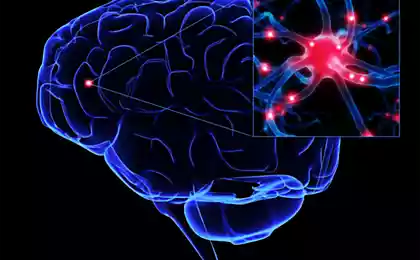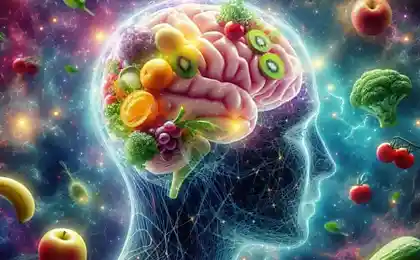The electromagnetic interaction of neurons

Hello, dear community Geektimes! The idea of the interaction of neurons not only through physical bonds (synapses efapsy), but also by means of electric fields for a long time is not new, but what is the nature and significance of these interactions?
Direct studies on this topic a little bit, this is due to the fact that a large effort on registration of changes in neurons under the influence of external electric fields. For example, the experiment conducted by neurophysiologists from the California Institute of Technology (CA Anastassiou, R. Perin, H. Markram, C. Koch (2011) Ephaptic communication in cortical neurons. - Nature Neuroscience [Abstract ], [PDF]), It showed that extracellular electric fields generated neurons, change the characteristics of other neuronal action potentials.
Despite the fact that a neuron has multiple contacts with neighboring cells, its range is limited in comparison with the magnitude of the nervous system. It becomes unclear how the switching of neurons during the formation of simple conditioned reflexes, since the distance between the different representations of certain reflexes, you can have up to hundreds of millimeters.
I.P. Pavlov explains the mechanism of formation of conditioned reflexes as follows. If the central nervous system, there are two centers of excitation, the stronger one "attracts" to itself the excitement of the less powerful. If this kind of strong and weak interaction centers of excitation combined again a few times, can form a conditioned reflex. Blockquote>
The transfer of excitation in the nervous system is always accompanied by a change in electromagnetic fields. It is natural to assume that the nature of the "Pavlovsky attraction" is electromagnetic in nature. Of course, there are hypothesis that neurons can interact on a quantum level, but the nature and character of these interactions is not clear and the refinement of quantum models should be postponed until the advent of quantum computers.
If you follow Pavlovsky ideas, each neuron is activated should determine the direction in which there is the strongest focus of excitation and, in consequence, to convey the excitement in the right direction. Neuron can remember this line and use it in the future. Here, the neuron is presented in the form of a switch. The network of switches forms a reflex arc, like an electrical circuit that can be configured to strengthen, restructure and break. Of course, the function of the adder reserved neuron that extends the capabilities of a self-organized system.
To test the hypothesis I developed a model in which the neuron is like a cellular automaton holds its internal calculations regardless of the system only on the basis of the information collected. Firstly, when receiving neuron excitation of its variable q (the charge) begins to be replaced with a frequency of 0, 01C, depending on the given array of numbers describing the variation of the charge on the surface of its membrane. Total sixteen values, then a neuron for a certain short period of time not responding to stimulation.
To demonstrate the present four options for changing the law charge, mainly characterized by a negative value of the trace capabilities. It is believed that trace capabilities are only the consequence of neuron repolarization. In his work on the model I came to the conclusion that the potential of the trace is essential for neuronal communication.

Secondly, after 0, 05s after activation neuron determines the direction of transmission of excitation and transmits it. To determine the most logical direction vector to apply Coulomb's law, but a microcosm of the cell is not so simple and one does not exclude the presence of organelle neurons capable to amplify signals to other neurons active. Therefore, the demonstration will present three rules for determining the direction vector:

The first rule - is the embodiment of Coulomb's law, the vector direction is defined as the sum of the vectors of interaction with every other activity of neurons. Vectors interaction - a product of the charge on the neuron unit vector divided by the square of the distance between neurons. The second rule is similar, but with the inverse distance. And the third law without taking into account the distance between neurons.
Further, the signal transmission is carried out to all the neurons in a particular direction vector direction in view of the range of the neuron, its focus, which is equal to 90 degrees.

If the direction of the vector will not neurons, it will create new neurons, and it will be transferred to the excitement. Dynamic creation of neurons has a technical meaning here, it makes the job more intuitive model, simplifies the rendering of her work.
From these observations, we can conclude that the Coulomb law is extremely inefficient, the influence of neighboring neurons is much stronger than the effect of other active portion of a larger field. Consequently, the "Pavlovian pull" can not be explained by the simple interaction of electrically charged particles.
When a rule is applied inversely proportional to and in combination with a small negative potential trace, it is already possible to observe the formation of "bridges" between the two excitation foci. These "jumpers" Academician IP Pavlov explained the formation of conditioned reflexes.
The most stable bond formation occurs when using the rule excluding the distance, although the nature of the implementation of such rules is difficult.
This model demonstrates the principle of the possible formation of reflexes, to this end has been deliberately simplified. Before I explain more complex reflexes or cognitive function, you must understand the nature of the behavior of a neuron and the nervous system.
I there is a hypothesis that the main role in the work of the functional neuron, like a switch, play микротрубочки. Presumably, they "grow" in the direction of the other active cells, under the influence of electromagnetic fields produced by their activity. Thus, a transport path for the created from the cell nucleus, protein mediators, which are then distributed between synapses. And the distribution is uneven, some synapses are often left without a mediator.
I would be grateful for your help in gathering information confirming the ideas set out in the said article and constructive criticism.
Source: geektimes.ru/post/267568/


























